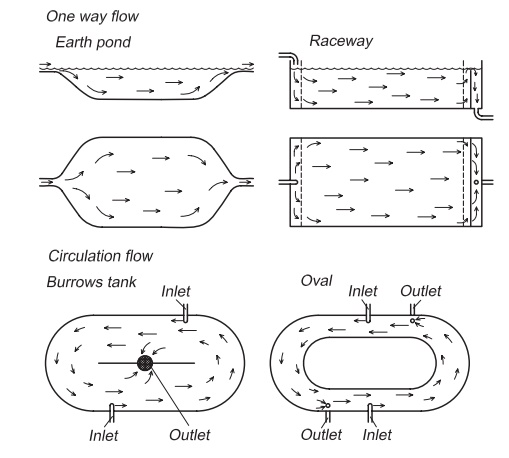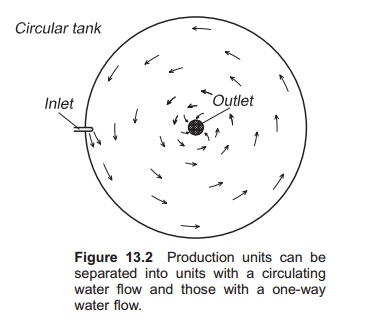Chapter: Aquaculture Engineering : Tanks, Basins and Other Closed Production Units
Types of closed production units - Aquaculture Engineering
Types of closed production units
The flow
pattern of the water in the unit can be used to classify closed production
units (Fig. 13.2):
· Production
units with a circulating water flow
· Production
units with a one-way water flow.


Production
units with a circulating water flow may again be separated into tanks with a
circular flow pattern (as is most common), or oval tanks that have an oval flow
pattern, of which there are several types; for example,
Foster Lucas tanks and Burrow tanks, as well as different ovals and pipe
connections. Among the traditional tanks with circular water flow, one type may
be defined as a farming silo. This is a circular tank of greater height than
diameter, i.e. a tower. It is normally difficult to achieve satisfactory water
exchange and self-cleaning in silos.
Earth ponds
belong to the group of production units with one-way water flow and represent
the oldest type of closed production units used for fish production. They are
mainly used for extensive fish farming; i.e. there is a low production per unit
farming volume.
According to
the requirements for closed production units, the main interest in using ponds
is the low initial cost per unit farming volume. In addition, normally a
natural ecosystem that can be utilized is created inside the ponds. In some
countries such as Norway, no new permits for earth ponds are given unless they
are dried once a year. This is because it is quite difficult to control disease
as pathogenic micro-organisms may survive in the earth. If the ponds are dried
during the winter season these micro-organisms will probably be killed. A layer
of lime which increases the pH may also be used as a disinfectant. If the ponds
are covered with a plastic tarpaulin (polyvinyl chloride (PVC) or polyethylene
(PE)) the problems are avoided because such ponds may be cleaned inside, but
this is not a normal pond design, and such installations are more like a
traditional tank with no ecosystem inside.
A further
development of the earth pond is the raceway, which also uses the one-way flow
pattern. This is a fixed construction often of concrete, built as a long
rectangle. The water is supplied at one end and the outlet is located at the
opposite end. Race-ways are quite commonly used for various species throughout
the world. However, raceways require quite large amounts of water to have
effective hydraulic self-cleaning of their total volume, and even then
it is very difficult to get good cleaning results. Normally, some kind of
mechanical equip-ment is necessary for additional cleaning of the raceway. It
is therefore important to create a good flow pattern inside the unit, with a
correctly designed flow inlet and outlet, to ensure uniform water flow through
the entire cross-sectional area and length of the raceway to reduce the
require-ment for manual cleaning. During the past few years, a specially
designed raceway with a very low water level (10–50 cm) has been developed. The unit is
specially designed for fish species that need a bottom to lie on and do not
utilize the entire water column, for example halibut and wolf fish. The unit is
constructed so that it can be installed in tiers, one above the other.
Closed floating
cages are also a type of closed production unit. In this case, both circulating
water flow and one-way flow systems have been tried in different variants that
have been constructed using different materials. In one variant the traditional
net bag in a sea cage has been substituted by plastic sheeting. Water is pumped
into the bag tangential to the edge and the outlet is placed in the centre of
the unit. This creates water circulation inside the bag (see, for example, Ref.
6). The advantage of this type of unit is that it lies on the water surface and
there is only a small head to over-come to pump the water into the cage,
compared with, for instance, closed production units placed on shore and where
seawater is normally pumped several metres.
As shown, a
closed productions unit can be built in several ways and can have different
water flow patterns. The design of the production units, however, depends on
the type of aquatic organism to be grown and its requirements regarding water
distribution and bottom conditions.
Related Topics